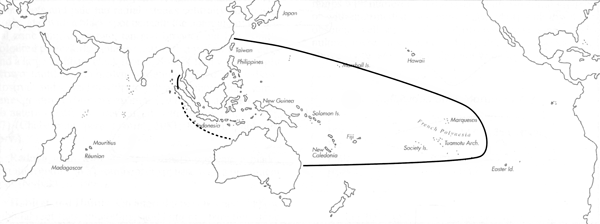Range: Tropical Central and W. Pacific except for Hawaii. We agree with Wils (1986) that records from the Red Sea (and probably also from other localities in the Indian Ocean) refer to C. flavidus.
Description: Moderately small to medium-sized, moderately solid to solid. Last whorl conical or ventricosely conical to broadly conical; outline convex at adapical third to half, almost straight below. Shoulder angulate, sometimes subangulate or nearly carinate. Spire of low to moderate height, outline straight to convex. Teleoconch sutural ramps usually flat; later ramps with 2-4 increasing to 4-5 distinct spiral grooves and additional striae. Last whorl usually with variably spaced, generally granulose spiral ribs from base to centre or shoulder; surface seldom largely smooth.
| Shell Morphometry | ||
|---|---|---|
| L | 28-56 mm | |
| RW | 0.18-0.40 | |
| (L 28-48) | ||
| RD | 0.61-0.73 | |
| PMD | 0.78-0.90 | |
| RSH | 0.08-0.18 | |
Colour olive to sometimes orangish or pinkish brown. Last whorl usually with a paler spiral band at or closely below centre and sometimes a second one at shoulder. Base purplish blue. Larval shell purple. Aperture purple, with paler bands near centre and below shoulder, often grading to pale blue deep within.
Periostracum yellowish to olivaceous brown, thick, opaque, with numerous axial ridges.
Dorsum of foot cream to pale yellow or tan, usually yellow anteriorly, often mottled with brown; anterior part usually with 3 black blotches in a clover-leaf arrangement, occasionally absent or fusing into a transverse band; posterior end with a few black spots beneath the operculum and sometimes with a black dorso-ventral blotch at each corner. Sides of foot often yellow to orange, mottled with brown and sometimes with scattered white dots. Sole of foot pale yellow to orange, often mottled and streaked with brown to olive, sometimes with a few brown dots. Rostrum and tentacles pale yellow to orange, sometimes with sparsely white dots. Siphon pale yellow to yellow or orange, darker towards tip, sometimes with a few white dots; a broad blackish brown to black band within anterior third and often a grainy grey second near centre (Pl. 81, Second row, left)(Kohn, unpubl. observ.; Chaberman, pers. comm., 1981; Pearson, unpubl. observ.). Observations by Kohn (unpubl.) from Indonesia and Okinawa suggest that orange colour tones are more prominent in subadult.
Radular teeth with an adapical barb opposite a blade; serration ending in a prominent cusp; base with a prominent spur (Nybakken, 1990).
Habitat and Habits: On intertidal benches and shallow subtidal reef flats to about 5 m; inhabiting bare beachrock or limestone, beachrock and limestone pavement with a thin layer of sand or with algal turf, sand-filled depressions, coral rubble with or without sand, and dead coral heads or rocks. C. frigidus feeds on sedentary polychaetes of the families Terebellidae and Capitellidae (Kohn & Nybakken, 1975; Leviten & Kohn, 1980; Reichelt & Kohn, 1985; Tirard, pers. comm., 1989). Females oviposit on the underside of coral rocks. Egg diameter of 191 ┬Ám suggests a minimum pelagic period of about 24 days (Perron & Kohn, 1985).
Discussion: C. frigidus is similar to C. emaciatus and can sometimes hardly be distinguished from C. flavidus. C. emaciatus attains somewhat larger size, has a narrower, more conical and less convex-sided last whorl (RD 0.56-0.62; PMD 0.89-0.94), a generally lower spire (RSH 0.03-0.14) and a largely white aperture; the colouration of its last whorl lacks greenish brown tones. C. flavidus also attains larger size, has a generally more conical, less convex-sided and smoother last whorl with spiral ribs usually only on the basal half, a lower spire (RSH 0.01-0.13) and a weaker spiral sculpture on its sutural ramps; its last whorl is typically yellow to orange brown and infrequently olive green; pale spiral bands are more often pronounced in C. flavidus. There are slight differences in animal coloruation and ecology between C. frigidus and C. flavidus, where both these species occur sympatrically.

C. frigidus range map
This section contains verbatim reproductions of the accounts of 316 species of Conus from the Indo-Pacific region, from Manual of the Living Conidae, by R÷ckel, Korn and Kohn (1995). They are reproduced with the kind permission of the present publisher, Conchbooks.
All plates and figures referred to in the text are also in R÷ckel, Korn & Kohn, 1995. Manual of the Living Conidae Vol. 1: Indo-Pacific Region.
The range maps have been modified so that each species account has it own map, rather than one map that showed the ranges of several species in the original work. This was necessary because each species account is on a separate page on the website and not confined to the order of accounts in the book.